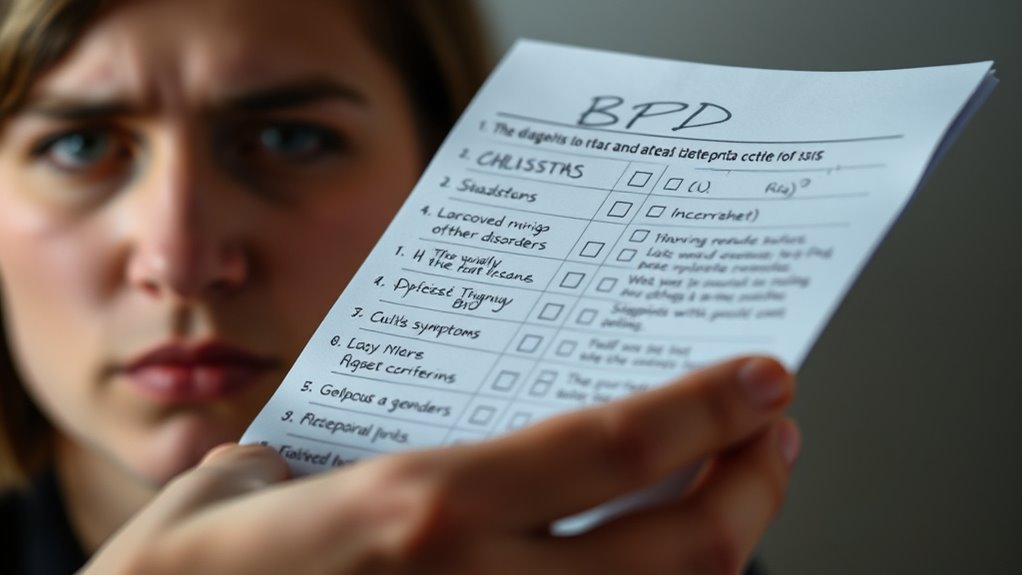To accurately diagnose BPD, you’ll want to understand the DSM-5 criteria, which require at least five of nine symptoms like emotional instability, impulsivity, and relationship instability, present across multiple situations and causing significant impairment. A detailed assessment by a qualified professional is vital to differentiate BPD from other disorders and evaluate symptom severity. Recognizing these patterns helps guarantee an accurate diagnosis—continue exploring to learn how thorough assessments can guide effective treatment.
Key Takeaways
- Diagnosis requires at least five of nine DSM-5 criteria, including emotional instability and relationship issues.
- Symptoms must be present across multiple settings and cause significant impairment.
- Structured assessment tools and clinical interviews ensure accurate evaluation of symptom severity.
- Differentiating BPD from other conditions relies on comprehensive history and symptom pattern analysis.
- Early and precise diagnosis guides effective treatment and helps address co-occurring mental health issues.
Recognizing the Key Symptoms of BPD

Recognizing the key symptoms of BPD can be challenging because they often fluctuate and overlap with other mental health issues. You might notice severe mood swings that change over hours or days, alongside intense emotions like rage, fear, or shame. Anxiety and panic can strike suddenly, especially when you face stressors, leading to unpredictable behavior that doesn’t always match your environment. Feelings of emptiness and loneliness tend to persist, making you feel disconnected from yourself. Your relationships may be unstable, shifting from idealization to anger or hatred quickly, with an intense fear of abandonment driving avoidance or clinginess. You might form strong attachments early on, but conflicts and misunderstandings are common. Recognizing these patterns is vital to understanding BPD’s complex emotional and relational landscape. Additionally, awareness of home environment influences can help in comprehending the development of these symptoms. External factors, such as early life experiences, can significantly impact the manifestation of BPD symptoms and their severity. Understanding the role of trauma history can also provide insight into the emotional regulation challenges associated with BPD. Recognizing how emotional dysregulation manifests can aid in distinguishing BPD from other conditions with similar symptoms. Moreover, understanding the neurobiological factors involved can shed light on the biological underpinnings of emotional instability.
The Role of DSM-5 Criteria in Diagnosis

The DSM-5 criteria guide you in identifying BPD by outlining specific symptoms and their severity. You need to see at least five of the nine criteria to make an accurate diagnosis, ensuring symptoms are present across different situations. This structured approach helps you distinguish BPD from other conditions and plan appropriate treatment. Incorporating mindful assessment strategies can further improve the accuracy of diagnosis by fostering a more comprehensive understanding of the patient’s experiences. Additionally, considering diagnostic tools such as standardized questionnaires can support clinicians in making consistent and reliable assessments. Being aware of symptom severity can also aid in differentiating between varying presentations of BPD and tailoring individualized treatment plans. Recognizing emotional regulation difficulties is crucial, as they are often central to the diagnosis and management of BPD.
Diagnostic Criteria Breakdown
How does the DSM-5 guide clinicians in diagnosing Borderline Personality Disorder? It provides nine specific criteria that capture the disorder’s intricacy, requiring you to identify at least five to establish a diagnosis. These criteria cover emotional instability, such as intense mood shifts lasting hours to days, chronic emptiness, and intense anger. It also emphasizes relationship instability, marked by rapid shifts between idealization and devaluation, often driven by fears of abandonment. Additionally, the DSM-5 highlights identity disturbance, with unstable self-image and shifting goals, and impulsivity in risky behaviors like spending, substance use, or self-harm. The content discoverability features of TikTok have made it a powerful platform for sharing information about mental health conditions, including BPD. By systematically evaluating these diagnostic criteria, clinicians can accurately assess whether an individual’s symptoms align with BPD, ensuring a thorough and evidence-based diagnosis. The structured approach of the DSM-5 also aids in differentiating BPD from other mental health conditions with overlapping features. Recognizing these criteria can help in applying early intervention strategies that may improve long-term outcomes.
Symptom Threshold Requirements
What role do the DSM-5 criteria play in establishing a diagnosis of Borderline Personality Disorder? They set clear symptom threshold requirements to guarantee accurate diagnosis. You need at least five out of nine criteria to be met, with symptoms causing significant distress or impairment across various areas. Symptoms must appear in multiple contexts, not just situational, to confirm their consistency. The criteria help clinicians differentiate BPD from other conditions and promote diagnostic reliability. Here’s a quick overview:
| Criterion Aspect | Details |
|---|---|
| Minimum Criteria | 5+ of 9 symptoms needed for diagnosis |
| Impairment Requirement | Symptoms cause significant functional impairment |
| Contextual Presence | Symptoms must be evident in multiple settings |
This standardization guarantees a reliable, thorough diagnosis process.
Additionally, the use of standardized diagnostic criteria ensures consistency among clinicians across different settings.
Understanding the Pattern of Interpersonal Relationships

You’ll notice that people with BPD often swing between idealizing and devaluing others, creating unstable relationship dynamics. Their intense fear of abandonment leads to clingy behaviors or desperate attempts to avoid rejection. Recognizing these patterns helps you understand the underlying emotional turmoil driving their interactions. This oscillation is a hallmark of BPD’s interpersonal instability, which can make relationships highly unpredictable and emotionally exhausting for both parties. Awareness of interpersonal relationship patterns can facilitate better support strategies and empathy for those affected. Additionally, understanding the emotional regulation challenges faced by individuals with BPD can improve responses and foster more compassionate interactions. Recognizing that these patterns may stem from deeply rooted trust issues can help in developing targeted approaches for effective intervention. Furthermore, being mindful of relationship warning signs can aid in early identification and intervention, helping to prevent further relational damage. Developing a nuanced understanding of attachment styles can also offer valuable insights into the relational behaviors associated with BPD.
Idealization and Devaluation
Idealization and devaluation are core patterns in borderline personality disorder that shape how you perceive and relate to others. You may see someone as perfect, attributing exaggerated positive qualities to them—this is idealization, which temporarily reduces your anxiety and helps you feel connected. However, when that person disappoints or threatens your sense of security, you might shift rapidly to devaluation, perceiving them as completely flawed or worthless. These black-and-white thinking patterns serve as defense mechanisms to manage emotional pain and ambiguity. Your relationships often swing between intense admiration and harsh criticism, leading to instability. Recognizing this pattern is essential for effective diagnosis and treatment. Understanding the underlying mental processes can help you develop healthier ways to relate to others. This pattern is often reinforced by emotional regulation difficulties, making it harder to maintain balanced perspectives in relationships. Reinforcing this understanding with interpersonal dynamics can further aid in addressing these issues effectively. Additionally, understanding personal finance management strategies like creating a savings plan or managing irregular income can provide a structured approach to stabilize other areas of life affected by emotional fluctuations. Recognizing how these patterns influence your behavioral responses can be a crucial step toward healthier relationships and emotional stability. Moreover, developing skills in wall organization can create a more calming environment that supports emotional well-being and reduces stress.
Fear of Abandonment
Fear of abandonment is a central pattern in borderline personality disorder that profoundly influences how you form and maintain relationships. This intense fear can cause significant anxiety, leading to irrational thoughts and behaviors that strain connections with others. You might feel distressed or panic when faced with real or imagined rejection, sometimes reacting impulsively or avoiding intimacy altogether. This fear often results in insecure attachment styles, making trust difficult and relationships fragile. You may try to control or cling to loved ones to prevent abandonment, which can push people away. As a result, relationships may fracture or break down under the weight of these fears. Recognizing this pattern is essential for understanding your interpersonal struggles and seeking effective treatment. Fear of rejection can amplify these anxieties, making it even harder to establish stable bonds. Additionally, understanding how data analysis influences perceptions and expectations can help in recognizing and challenging distorted thoughts related to abandonment. For example, recognizing the symptoms of grape poisoning can be crucial in managing health-related fears that sometimes intertwine with emotional insecurities. Exploring how personality test insights reveal individual traits may also provide deeper awareness of underlying attachment patterns.
Identifying Identity Disturbance and Self-Image Issues

Identifying identity disturbance and self-image issues is essential in diagnosing borderline personality disorder because these features are central to understanding your internal experience. You may experience a markedly unstable self-image or sense of self, which persists across different areas of life and causes significant distress. Unlike normal questioning, this instability is severe and ongoing, often leading to fluctuating goals, values, or career plans. You might feel persistent self-doubt or rely heavily on others’ validation to define yourself. This instability can trigger emotional fluctuations, feelings of emptiness, and difficulties maintaining consistent roles in relationships or work. Recognizing these patterns helps distinguish BPD from other disorders and highlights the importance of targeted therapies like DBT to support self-discovery and stability. Research indicates that understanding the core features of identity disturbance can significantly improve diagnosis accuracy and treatment outcomes.
Assessing Impulsivity and Risky Behaviors

Impulsivity and risky behaviors are prominent features in borderline personality disorder that directly impact how you function daily. To assess this, clinicians look for impulsive actions in at least two areas, such as spending, sex, substance use, reckless driving, or binge eating. These behaviors often stem from deficits in response inhibition and a preference for immediate rewards. Evaluating these patterns involves examining how they affect your life and recognizing the psychological and biological factors behind them. While the DSM provides specific criteria, limitations exist, prompting ongoing research to improve understanding. Being aware of these impulsive tendencies is essential for diagnosis and treatment planning, helping address the underlying mechanisms that drive self-damaging behaviors and improve your overall functioning.
The Significance of Emotional Instability and Mood Reactivity

Have you ever noticed how quickly your mood can shift in response to everyday events? Emotional instability and mood reactivity are core features of BPD. You might experience intense feelings of dysphoria, irritability, or anxiety that last just hours or days. This volatility often impacts your relationships, leading to cycles of idealization and devaluation. Your mood may react sharply to minor triggers, making daily life unpredictable. Recognizing these patterns is essential because:
Mood swings and emotional shifts happen quickly, impacting relationships and daily life.
- Mood swings occur rapidly, often within hours.
- Emotional reactions are heightened, even to small events.
- You may feel chronic emptiness tied to emotional instability.
- Stress can worsen mood reactivity, causing additional symptoms.
Understanding these dynamics helps in diagnosing BPD accurately and tailoring effective treatment strategies.
Challenges in Differentiating BPD From Other Disorders

Differentiating BPD from other mental health disorders presents significant challenges because many symptoms overlap across conditions. For example, depression, anxiety, and PTSD often coexist with BPD, making it hard to pinpoint specific traits. Mood swings and impulsive behaviors are common in both bipolar disorder and BPD, but BPD involves more pervasive relationship and self-image issues. Substance use disorders further complicate diagnosis, as they can mimic or mask BPD symptoms. Distinguishing BPD from other personality disorders, like avoidant or narcissistic, requires careful assessment of emotional instability, fears of abandonment, and identity issues. Clinicians must rely on detailed evaluations, considering the nuances of each condition, to avoid misdiagnosis and ensure appropriate treatment.
The Importance of a Comprehensive and Qualified Assessment

A detailed and qualified assessment is essential for accurately diagnosing BPD because it guarantees all relevant symptoms and behaviors are thoroughly evaluated across different areas of your life. This thorough approach helps identify co-occurring conditions and ensures the correct application of DSM-5 criteria, reducing misdiagnosis risk. When conducted by trained professionals, it incorporates standardized tools, clinical interviews, and collateral information to build a detailed profile.
Thorough assessments ensure accurate BPD diagnosis by evaluating symptoms, co-occurring conditions, and applying DSM-5 criteria precisely.
- Identifies symptoms across personal, social, and occupational domains
- Reveals co-occurring mental health issues impacting treatment
- Confirms symptom persistence over time for accuracy
- Supports individualized treatment planning based on specific needs
Frequently Asked Questions
How Long Must Symptoms Be Present to Diagnose BPD?
You’re wondering how long symptoms need to be present to diagnose BPD. Typically, symptoms should persist for at least a year in individuals under 18, though diagnosis often occurs when symptoms are severe and consistent. For adults, there’s no strict minimum duration, but healthcare providers look for persistent patterns over time. They assess how long your symptoms have lasted and how they impact your life to make an accurate diagnosis.
Can BPD Symptoms Change Over Time?
Yes, BPD symptoms can change over time. You might notice rapid shifts in your mood, behaviors, or perceptions, sometimes within hours or days. These fluctuations can come and go, making your experiences feel unpredictable. External factors and your environment also influence how symptoms present. Understanding that your symptoms can vary helps you and your treatment team develop effective strategies to manage and cope with these changes.
What Role Do Cultural Factors Play in Diagnosis?
Think of cultural factors as the lens through which you see the world, much like a colorful stained glass window. They shape how you interpret emotions, behaviors, and relationships, influencing how BPD symptoms manifest and are understood. You must consider these cultural nuances during diagnosis to avoid misjudging or missing symptoms. Recognizing cultural context guarantees you get an accurate picture, respecting each person’s unique background and experience.
How Do Clinicians Differentiate BPD From Bipolar Disorder?
You differentiate BPD from bipolar disorder by examining mood patterns, triggers, and core symptoms. In BPD, mood swings are rapid, reactive, and linked to interpersonal events, with chronic feelings of emptiness and fear of abandonment. In bipolar, mood episodes are episodic, with clear manic, hypomanic, or depressive phases, often without external triggers. You also assess impulsivity, anger, and psychosis presence, using standardized tools like the PID-5 algorithm for accuracy.
Is There a Genetic Predisposition for BPD?
So, you wanna know if genetics play a role in BPD? Well, surprise! It’s not just your chaotic mind, but also your genes whispering sweet nothings. With about 40% heritability, genetic factors definitely influence BPD risk. Certain genes like CACNA1C and ODZ4 are linked, and your family’s mental health history might give you a heads-up. Genetics and environment are like dance partners in this complex disorder.
Conclusion
Getting diagnosed with BPD is like discovering you’ve been walking around with a storm inside you that everyone else could see but no one could name. By understanding the key signs and trusting a qualified professional, you’re opening the door to clarity and hope. It’s not just a label—it’s your first step toward mastering that wild emotional rollercoaster and finally feeling like you’re in the driver’s seat of your own life.









